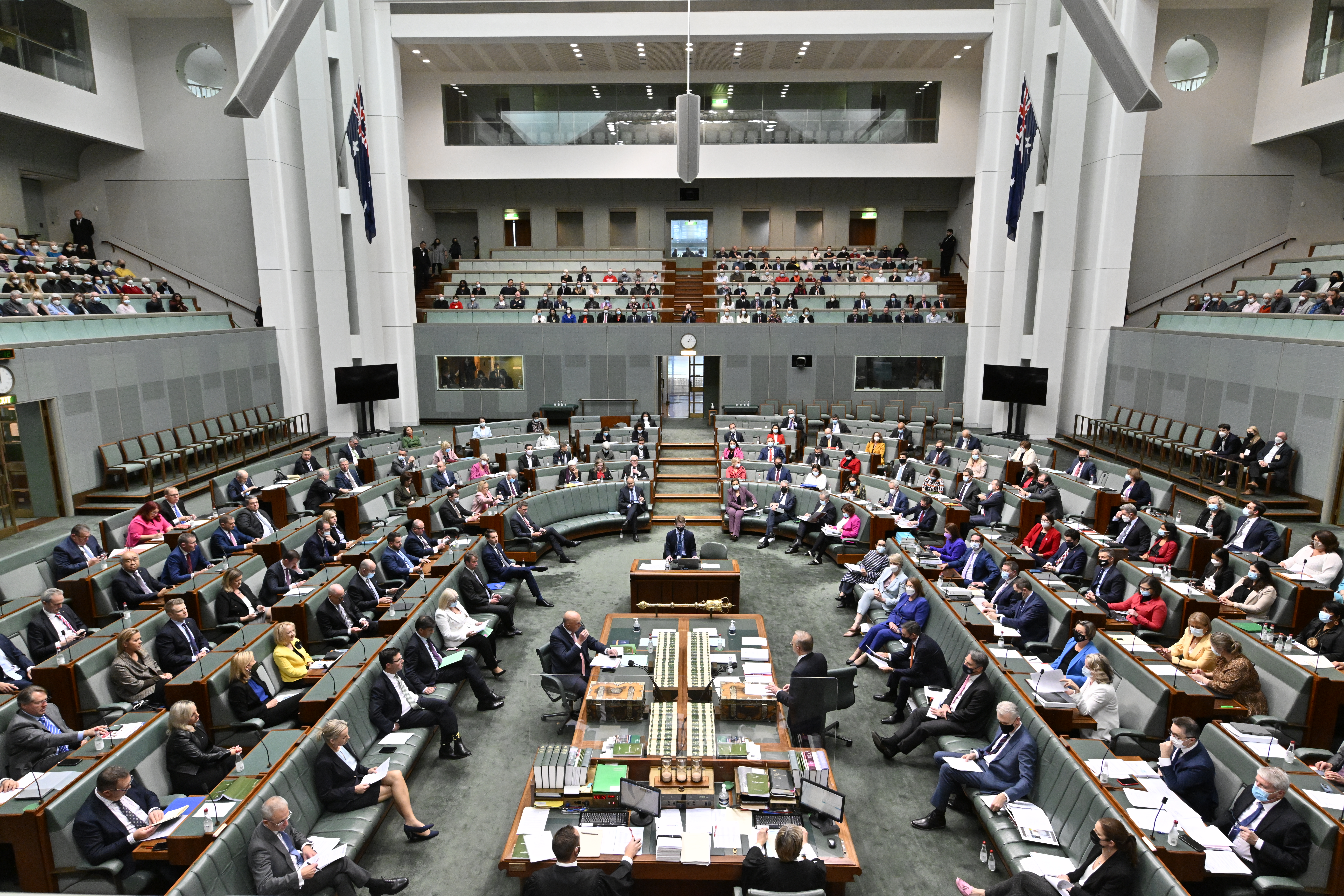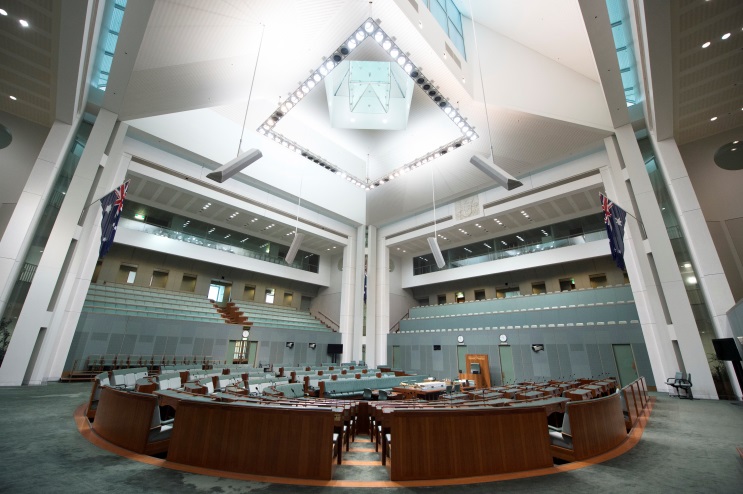Sittings of the House of Representatives operate in a similar way to meetings of any other formal body such as a local council or community association. The House has written rules called ‘standing orders’ which govern its operations, the times of its meeting and the type and order of business undertaken. So that members and other people involved can prepare for business they are interested in, there is a set order for considering business each day and formal agenda papers are published. While there is enough flexibility in the rules to adapt the routine to varying circumstances, the basic structure generally remains the same and is outlined below.
The start of a sitting day
Bells ring throughout Parliament House for five minutes prior to the time fixed for the meeting of the House, to call members to the Chamber. Green lights flash to indicate the call is for members of the House of Representatives—red lights are used to call senators. As the bells stop, the Speaker enters the Chamber, preceded by the Serjeant-at-Arms carrying the Mace—the symbol of the House’s authority—to signify that the House is in session. The Speaker commences proceedings by making an Acknowledgement of Country and reading Prayers (as set out in the standing orders), with members standing, and then calls on the first item of business.
Time of meeting
The parliamentary sittings for each calendar year are set out in a schedule which is agreed to by the House. They are available at www.aph.gov.au/calendar. The routine of business for each sitting day is provided for in the standing orders of the House. Meeting times are:
|
Commencement |
Adjournment |
| Monday |
10 am |
8 pm |
| Tuesday |
12 noon |
8 pm |
| Wednesday |
9 am |
8 pm |
| Thursday |
9 am |
5 pm |
The normal order of business
The normal order of business on Tuesdays, Wednesdays and Thursdays is as follows:
-
Statements on significant matters (if required, on Wednesdays and Thursdays only)
-
Government business
-
Members’ 90 second statements (at 1.30 pm)
-
Question Time (at 2 pm)
-
Presentation of documents
-
Discussion of a matter of public importance
-
Ministerial statements (if any)
-
Government business
-
Adjournment debate
The order of business on Mondays is different and is described later in this infosheet. See also www.aph.gov.au/house/business.
Question Time
Question Time begins at 2 pm with the Speaker asking ‘Are there any questions?’. Members stand to attract the Speaker’s attention and the Speaker selects the first questioner, traditionally an opposition member. Thereafter, questions alternate between government and non-government members. Question Time finishes (usually after about 70 minutes) when the Prime Minister or another minister asks that further questions be placed on the Notice Paper. In effect this means that no more oral questions can be asked that day. Members can lodge questions in writing for a written response (i.e. place them on the Notice Paper) and/or wait until Question Time the next day.
Question Time is a period when the Government and the Opposition test each other’s political skills, trying to highlight their own achievements and find weaknesses in their opponents. It can be spirited and intense. During Question Time most members are usually present, the galleries are full and media attention is at its greatest (see Infosheet No. 1 Questions for more detail).

Question Time
Presentation of documents
The Government’s responsibility to account for its activities to the House is demonstrated when ministers present (or table) government documents in the House—thus making them public. These documents include annual and other reports of government agencies and reports of investigations into government administrative matters. A minister, usually the Leader of the House, announces that documents are tabled in accordance with a list circulated to members earlier that day. If a minister wishes to make a statement in connection with any document they will present the document separately.
Following presentation the Leader of the House or another minister may move that the House take note of particular documents. The motion ‘That the House take note of the document’ is used as a means to enable a document to be debated, either at the time it is presented or, more usually, at a later sitting. However, in recent times this practice is rarely used for government documents.
Matter of public importance
A matter of public importance, or MPI, is a discussion (on which no vote is taken) on a single topical issue, usually proposed by the Opposition and often critical of the Government’s handling of a matter. A member wishing to initiate such a discussion must write to the Speaker before 12 noon setting out the terms of the matter. The Speaker reads out the proposed matter to the House. Discussion may proceed if it is supported by at least eight members.
The Opposition usually arranges for one of its members to propose a matter for discussion. Crossbench of Government members may also propose a matter. If more than one MPI is proposed the Speaker must decide which one should be discussed. Sessional orders adopted for the 47th Parliament provided that the Speaker shall have regard to the crossbench proportion of the non-government membership of the House in selecting matters proposed.
Under the standing orders up to one hour is allowed for the discussion, but it may be ended before the allotted time by any member (in practice a minister) moving ‘That the business of the day be called on’.
Ministerial statements
By leave of the House, that is, agreement of all members present, ministers may make prepared statements about government policy or other matters for which they have ministerial responsibility. This is another example of the government accounting for its actions to the House.
Ministerial statements are not an everyday occurrence but, if made, are usually made at this stage of the day’s proceedings. It is normal practice for the opposition spokesperson on the subject, and occasionally other members, to be permitted to make a statement in response to the minister. Arrangements for ministerial statements are, in practice, negotiated beforehand with the opposition, which is supplied with advance copies of a minister’s intended statement.
Government business
(notices and orders of the day)
Most of the time of the House is taken up with government business.
Notices are written advices or notifications of motions to be moved or bills (proposed laws) to be presented. Notices must be signed and lodged during proceedings and are published on the Notice Paper for the next day. When a notice is called on (that is, announced) by the Clerk the relevant minister moves the motion or presents the bill concerned. Most notices are for the presentation of bills. Following presentation, a bill is formally read a first time (that is, its title is read out by the Clerk), the minister explains the principles of the bill (second reading speech) and presents to the House an explanatory memorandum containing a detailed explanation of the reasons for, and clauses of, the bill.
An ‘order of the day’ is a matter that has come before the House earlier and which the House has decided should be considered further at a later date. Orders of the day are often for the resumption of the second reading debates on bills. Other orders of the day could be the resumption of debate on motions to take note of documents. When an order of the day is called on by the Clerk, debate is resumed at the point at which it was stopped earlier. If an order of the day before the House is not disposed of (that is, voted on and decided), it continues as an order of the day for the next sitting.
Notices and orders of the day are called on by the Clerk in the order in which they appear on the Notice Paper. This is the order determined by the Government before the Notice Paper is published, usually at the end of the previous day. Other business may be interspersed; for example, a minister may present a taxation bill for which notice is not required. Although not appearing on the Notice Paper, such items would normally be included in the Daily Program, a published informal guide to the day’s business.
The length of time devoted to debate on each item depends on its urgency, the amount of time available and the number of members wishing to speak on it. Usually such matters are arranged by negotiation between the parties.
When debate on an item of business has finished, a vote is taken. This may be ‘on the voices’ (that is, without a count) or by division if demanded by more than one member. If a division is called, the bells are rung to summon members to the Chamber and the House divides, that is, members move to opposite sides of the Chamber for their votes to be counted for or against.
Adjournment debate
Thirty minutes before the House is scheduled to adjourn (finish meeting for the day) the Speaker proposes the question ‘That the House do now adjourn’ (a minister may move the motion earlier if other business has been completed). Any business interrupted in this way is placed on the Notice Paper for consideration the next day. While in most debates members must remain relevant to the question being debated, special rules allow them to speak on any subject during debate on the adjournment motion. This debate is particularly valued by private members because they can use it as a time to raise matters of individual or constituency concern. Each member may speak for five minutes. The call is alternated between non-government and government members. At 8 pm on Mondays, Tuesdays and Wednesdays and 5 pm on Thursdays, the Speaker interrupts the debate. At this stage a minister may require the adjournment debate to be continued, for a maximum of ten minutes, in order to reply to points raised by members during the debate. If the debate is not required to be continued, or after the conclusion of the minister’s reply, or after 10 minutes, the Speaker adjourns the House until the time of its next meeting.
Other business and interruptions
As necessary and convenient, other business, for example the announcement of communications (‘messages’) from the Governor-General or the Senate, or the presentation of documents or committee reports, may be taken between items of scheduled business. Interruptions can occur by, for example, members querying procedure or other issues relating to the rules (raising a point of order), calling for a quorum (see below) or, with the permission of the Chair, explaining a personal matter such as a misrepresentation of something they have said (most personal explanations occur at the conclusion of Question Time).
Preliminaries—setting the agenda
Prior to each sitting of the House (other than the first of a session of parliament) a Notice Paper, or agenda, is published. The Notice Paper lists all business currently before the House and all business intended to come before the House for which notice (that is, advance warning) has been given—thus covering business to be considered over several weeks. Items of business are listed in the order they are to be considered.
An outline of the business planned for each day can be obtained from the Daily Program, often called the ‘Blue’ because it is traditionally printed on blue paper. The Daily Program shows only the business expected to be dealt with on a particular day. Unlike the Notice Paper it is not a formal document, but is a very useful guide. Both these documents can be accessed from the House’s website: www.aph.gov.au/house/chamberdocs.
Quorum and presence of members
Except during Question Time and special events, members are present in the Chamber at different times throughout the sittings. Members are busy people with many demands on their time. Besides their duties in the Chamber itself and in the Federation Chamber (see below), they have meetings of parliamentary and party committees to attend, research to undertake, speeches to prepare and innumerable matters to deal with on behalf of their constituents. The demands on the time of ministers and office holders, with more public duties and administrative responsibilities, are even greater.
The quorum of the House (the minimum number of members required to be present) is one fifth of its members, that is, 31. A quorum must be present when the sitting begins and when a division occurs. Otherwise the House can, and often does, conduct its business with fewer members present. However, any member may at any time insist on the presence of a quorum by drawing the Chair’s attention ‘to the state of the House’. On a quorum being called for, the bells ring to summon members, who stop whatever activity they are engaged in to go to the Chamber. If a quorum is called between 10 am and 12 noon on Mondays, or before 2 pm on Tuesdays, the count is postponed until later in the day. Quorums called between 6.30 pm and 7.30 pm on Mondays, Tuesdays and Wednesday are deferred until the following sitting. It is accepted practice that a quorum will not always be present, as it is acknowledged by all parties that members have other legitimate demands on their time. Members are able to follow the proceedings in the Chamber on closed circuit televisions in their Parliament House offices.

House of Representatives Chamber
Federation Chamber
The House has established a Federation Chamber (formerly known as the Main Committee) to take some of the workload of considering bills, motions and reports. It operates in much the same way as the House itself and acts as a second debating chamber. Orders of the day may be referred by the House for debate in the Federation Chamber. Meeting times are:
| |
Commencement |
Adjournment |
| Monday |
10.30 am |
1.30 pm |
| |
4 pm |
7.30 pm |
| Tuesday |
4 pm |
7.30 pm |
| Wednesday |
9.30 am |
1 pm |
| |
4 pm |
7.30 pm |
| Thursday |
9.30 am |
1 pm |
The Federation Chamber may also meet at other times if the amount of business necessitates (but the House must be sitting at the same time). On days the Federation Chamber meets, a program is published as an attachment to the Daily Program. Federation Chamber business is listed on the Notice Paper. For details of the operation of the Federation Chamber see Infosheet No. 16 The Federation Chamber.
Private members’ time
Time is set aside for private members’ business and committee and delegation business on Mondays in the House and Federation Chamber and for committee and delegation business on each day the Federation Chamber meets. Items include:
-
petitions (presented to the House by the Chair of the Petitions Committee on Mondays and presented by members at certain times in the House and Federation Chamber)
-
members’ 90 second statements in the House (each sitting day) and Federation Chamber (on Mondays) and 3 minute constituency statements in the Federation Chamber (each day it meets)
-
statements on parliamentary committee and delegation business (in the House and Federation Chamber on Mondays)
-
debate on committee reports already presented (in the Federation Chamber on Tuesdays, Wednesdays and Thursdays)
-
private members’ business (motions and bills sponsored by private members—in the House and Federation Chamber on Mondays)
-
grievance debate (Federation Chamber on Tuesdays).
Infosheet No. 6 Opportunities for private members describes these proceedings in detail.

Private member addressing the House
For more information
House of Representatives Practice, 7th edn, Department of the House of Representatives, Canberra, 2018, pp. 243–88.
House of Representatives Order of Business Chart available from: www.aph.gov.au/house/chamberdocs.
About the House website: www.aph.gov.au/athnews.
Facebook: Aboutthehouseau
X: @AboutTheHouse
Images courtesy of AUSPIC.